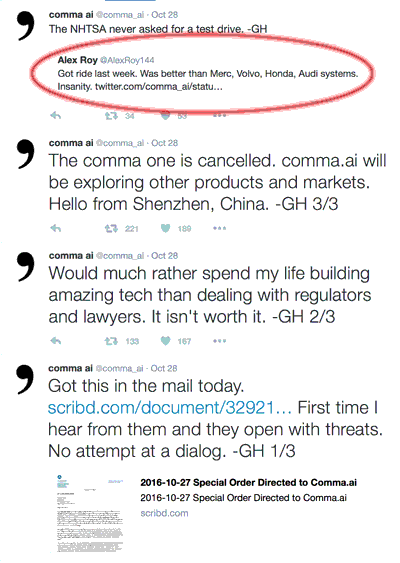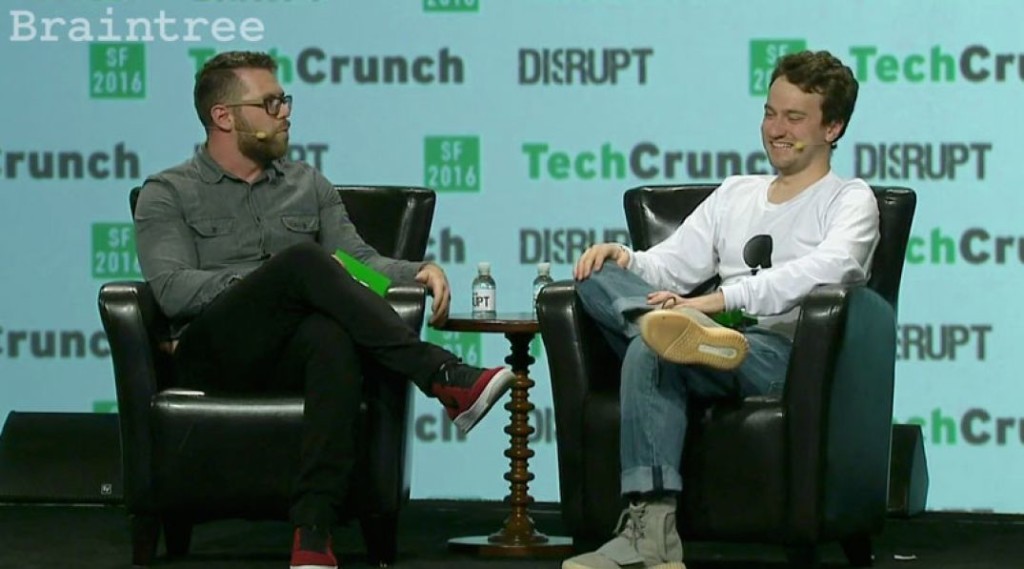
Robohub.org
The delicate balance between brilliance, safety and arrogance
Silicon Valley and other technology centers have their share of brilliant minds. Some of them have similarly outstanding egos. A few of those have very short fuses. Such is the story of George Hotz.
Hotz is certainly brilliant. He was the first person to unlock the iPhone and hack the PlayStation3. Recently his 2,000-line deep learning code, plus car hacks to capture the car’s digital systems, and his driving model, has learned how and written code to drive a car. He demonstrated this to a Bloomberg reporter earlier this year after which he got some funding, hired a team of engineers and turned that software into an inexpensive product – the green thing in his hand – which he promoted at TechCrunch Disrupt SF in September. The green device, the Comma One, is a $999 aftermarket add-on kit with a $24 monthly subscription fee for select Honda and Acura cars. The device replaces the rear-view mirror and captures the car’s radar, steering, braking system and gas pedal. It also adds a camera.
Hotz said that there were 750 of these devices at work in Beta test vehicles around the area, state and country.
The TechCrunch video is in two parts: Hotz’s 7-minute product presentation and an in-depth Q&A with Darrell Etherington which is also informative and worth watching.
Part of Hotz’s talk was a review and critique of other companies making self-driving kits and self-driving cars. “Shippability” was his criteria and by that token, only Tesla has shipped and delivered a self-driving car. He was particularly hostile to the Cruise Automation people saying that they had sold out their original intention to build and sell an aftermarket kit. [For another spin on Cruise, see below.] The most politically correct thing I can say about that portion of his presentation was that his remarks were youthful.
Enter the NHTSA (National Highway Transportation Safety Agency) with a strongly worded query and special order about the safety of Comma One.
“Recently, NHTSA has become aware that your company intends to sell a product, the “comma one,” that you claim allows certain Honda vehicles (and potentially certain Acura vehicles) to operate in a semi-autonomous mode. In a blog post dated October 20, 2016, you described your product as an “advanced driver assist system,” or “in traditional auto manufacturer terms: as “lane keeping assist” and “adaptive cruise control.” You assert that the product “should be legal.”
“This “aftermarket upgrade,” as you describe it, is replacement motor vehicle equipment and your company is a manufacturer of motor vehicle equipment subject to the requirements of the National Traffic and Motor Vehicle Safety Act (Safety Act), 49 U.S.C. Chapter 301, under NHTSA’s oversight. It is essential that you are aware of and in full compliance with your legal responsibilities to ensure vehicle safety before introducing this product into commerce.”
The NHTSA Special Order (SO) said that Comma.ai must respond under oath and accompanied by an affidavit, to 15 “requests,” or be fined up to $21,000 per day and/or become the subject of a civil action to compel responses. The SO asked Hotz to describe, in detail, how the Comma One is installed, what features it offers, how the driver can use the product, what conditions constitute safe operations of the device, what types of operator controls, roads, areas, speeds and environmental conditions such as weather or time of day may a car equipped with the Comma One operate safely and what testing procedures have been implemented to attest to those claims. Each of the questions requires a detailed description of the basis to determine safe operation conditions. Finally, by replacing the rearview mirror, how will the Comma One block or obstruct the drivers’ ability to have sufficient rear view.
[I don’t know if the NHTSA’s letter and SO are particularly harsh but, certainly, their concern for safety is evident as it should be; and as it should be for Hotz and the Comma.ai team. Governments and their regulations are an integral part of the process of bringing a new product like the Comma One to market. Certainly, it was in their domain to request testing and safety methods from Comma. But Comma’s response was definitely not predictable.]
A day later Hotz Tweeted the bottom three messages you see (read from bottom to top). Thus Hotz cancelled Comma’s first official product even though an admirer says it was the best autonomous driving experience (top Tweet).

Hotz said that Comma would turn its attention to “other products and markets.” It’s unclear what those new products will be. But it is clear that this is a major change in direction at Comma, perhaps even the beginning of its demise.
There’s a saying that at some point every startup needs to bring in an adult to handle the difficult, distasteful, and often diplomatic tasks that happen in business and with strong-willed inventors.
Perhaps now would be a good time for Comma.ai to hire that adult (although it might be a little late).
Cruise Automation
For those of you who thought the billion dollar acquisition of Cruise was a fluke, read on. One billion dollars! That’s what GM paid earlier this year. $300 million in cash; $300 million in GM stock and the remainder in incentives to retain key employees.
Up until news about the acquisition, Cruise was known as the developer of an aftermarket kit to turn select cars into self-driving cars. Actually Cruise had abandoned the kits almost a year earlier to build software instead. That’s what attracted GM.
A new article in Fortune by Erin Griffith sheds some insight and details into Cruise, its two founders, Kyle Vogt and Daniel Kan, and its importance to GM.
“Since the deal closed, Cruise has more than doubled its staff. The company’s office is filling up quickly. Office space in San Francisco is already scarce and pricey, and Cruise has a unique challenge: It needs to drive cars in and out of the office. Beneath Cruise’s barnlike warehouse is a fleet of Chevy Bolts, each outfitted with LiDAR laser sensors. There’s only one ramp in and out of the basement. The cars are starting to feel crowded too.
Cruise could solve its problem by moving its operations to the suburban sprawl of Silicon Valley proper. Like all the automakers, GM has an innovation outpost in Palo Alto. But no one at Cruise has even visited it. Staying independent is too important.”
Read the complete Fortune article here.
If you liked this article, you may also want to read these articles about autonomous cars:
- Comma.ai cancels comma-one add-on box after threats from NHTSA
- What to expect from autonomous cars
- How much can customers test robocars?
- The inevitability of the global march toward self-driving vehicles
- Two New Year’s resolutions for developers of automated vehicles
- comma.ai’s neural network car and new technology in robocars
See all the latest robotics news on Robohub, or sign up for our weekly newsletter
tags: Automotive, comma one, comma.ai, Frank Tobe, The Robot Report




